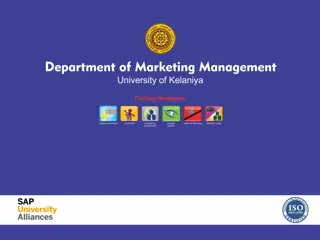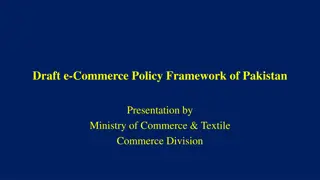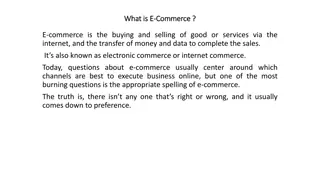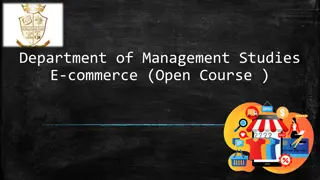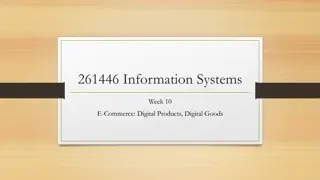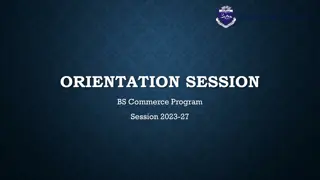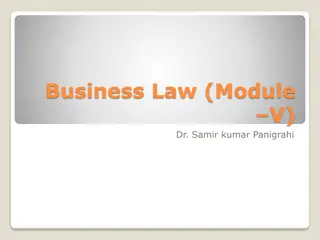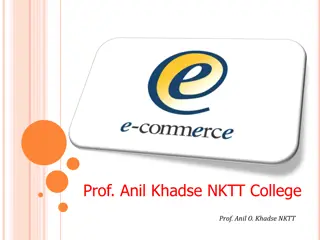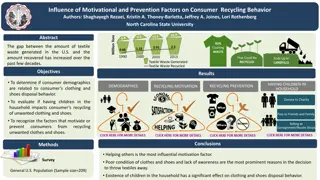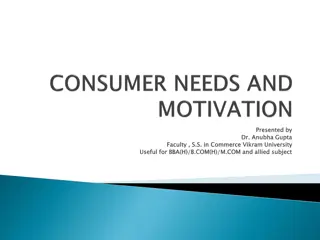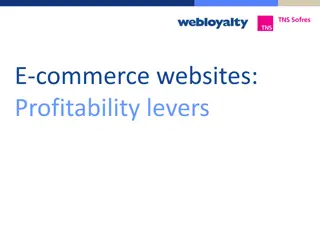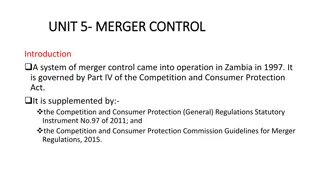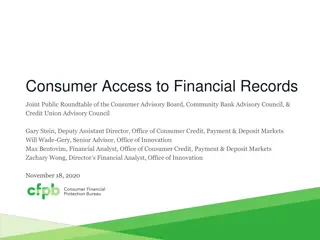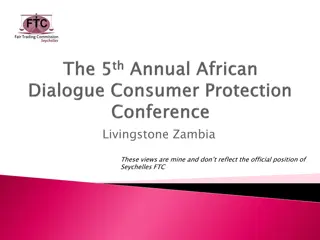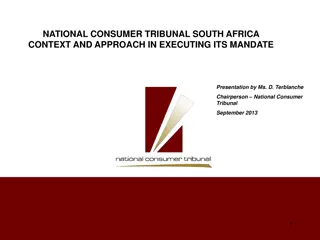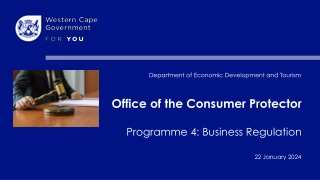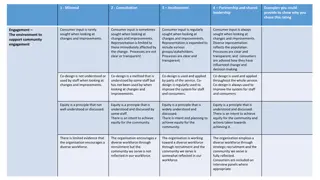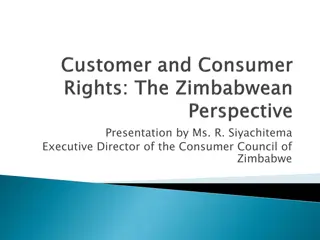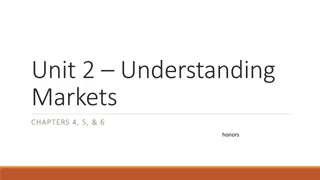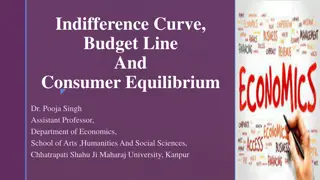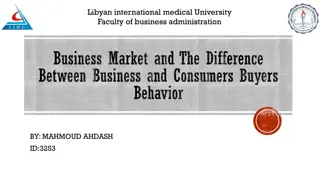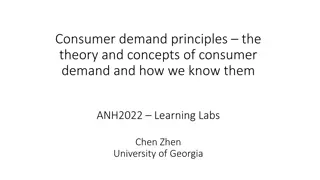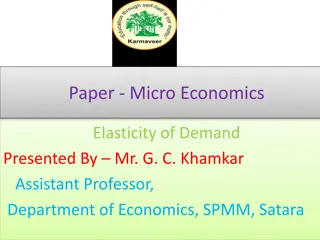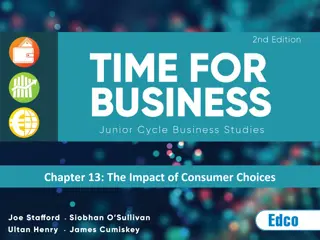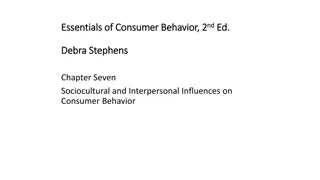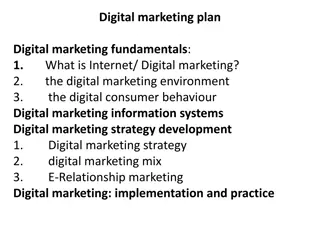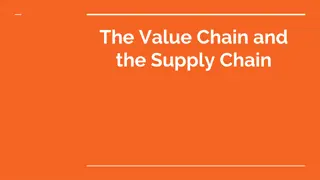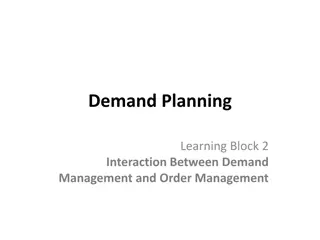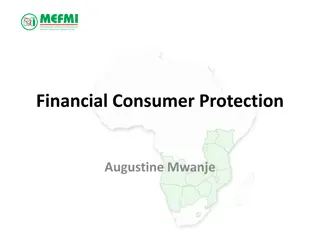Understanding Consumer Behavior in E-Commerce: Factors and Strategies
Explore the intricacies of consumer behavior in the online marketplace with a focus on influencing factors, decision-making processes, building customer relationships, and online advertising strategies. Dive into the model of online consumer behavior, including independent and intervening variables, and the role they play in shaping buyers' decisions. Discover the significance of personalization, e-loyalty, and e-trust in e-commerce, along with insights into internet marketing, web advertising, and various online advertising methods. Gain valuable knowledge on how companies are adapting to meet the evolving needs of online consumers.
Download Presentation

Please find below an Image/Link to download the presentation.
The content on the website is provided AS IS for your information and personal use only. It may not be sold, licensed, or shared on other websites without obtaining consent from the author. Download presentation by click this link. If you encounter any issues during the download, it is possible that the publisher has removed the file from their server.
E N D
Presentation Transcript
Consumer Behavior, Market Consumer Behavior, Market Research, and Advertisement Research, and Advertisement E E- -Commerce Commerce Marcello Singadji, S.Kom, M.T marcello.singadji@gmail.com E-Commerce Marcello Singadji
Learning Objectives 1. 2. 3. 4. 5. 6. Describe the factors that influence consumer behavior online. Understand the decision-making process of consumer purchasing online. Describe how companies are building one-to-one relationships with customers. Explain how personalization is accomplished online. Discuss the issues of e-loyalty and e-trust in EC. Describe consumer market research in EC. E-Commerce Marcello Singadji e-Commerce Marcello Singadji | marcello.singadji@upj.ac.id
Learning Objectives 7. Describe Internet marketing in B2B, including organizational buyer behavior. 8. Describe the objectives of Web advertising and its characteristics. 9. Describe the major advertising methods used on the Web. 10.Describe various online advertising strategies and types of promotions. 11.Describe permission marketing, ad management, localization, and other advertising-related issues. 12.Understand the role of intelligent agents in consumer issues and advertising applications. E-Commerce Marcello Singadji e-Commerce Marcello Singadji | marcello.singadji@upj.ac.id
4.1 Learning about Consumer Behavior Online A Model of Consumer Behavior Online A Model of Consumer Behavior Online Independent Independent (or uncontrollable) variables can be categorized as personal characteristics and environmental characteristics Intervening Intervening (or moderating) variables are variables within the vendors control. They are divided into market stimuli and EC systems The decision decision- -making process making process is influenced by the independent and intervening variables. This process ends with the buyers decisions resulting from the decision-making process The dependent dependent variables describe types of decisions made by buyers (buyers control) E-Commerce Marcello Singadji e-Commerce Marcello Singadji | marcello.singadji@upj.ac.id
Independent Variables Buyer s Decision Dependent Variables (Results) Buy or not? What to buy? Where (vendor)? When? How much to spend? Intervening (vendor- controlled) Variables E-Commerce Marcello Singadji
Exhibit 4.9 EC Consumer Behavior Model Personal Characteristics Environmental Characteristics Age Gender Ethnicity Education Lifestyle Psychological Knowledge Values Personality Social Cultural/community Other: legal, institutional, governmental Independent Variables Market Stimuli Buyer s Decision Decision Process (Group or Individual) Price Brand Promotions Advertising Product quality Design Buy or not? What to buy? Where (vendor)? When? How much to spend? Intervening (vendor- controlled) Variables EC Systems Dependent Variables (Results) Logistics Support Technical Support Customer Service Payments Delivery Web design and content Intelligent agents Security E-Commerce Marcello Singadji e-Commerce Marcello Singadji | marcello.singadji@upj.ac.id
Learning about Consumer Behavior Online (cont.) Independent variables Personal characteristics (demographic variables) Age, gender Ethnicity, education Lifestyle, knowledge Value, personality Environmental variables Social variables Cultural/community variables Institutional, governmental variables N E-Commerce Marcello Singadji e-Commerce Marcello Singadji | marcello.singadji@upj.ac.id
Learning about Consumer Behavior Online (cont.) Intervening (moderating) variables variables are those that can be controlled by vendors Dependent variables: the buying decisions customer makes several decisions customer makes several decisions to buy or not to buy? to buy or not to buy? what to buy? what to buy? where, when, and how much to buy? where, when, and how much to buy? N E-Commerce Marcello Singadji e-Commerce Marcello Singadji | marcello.singadji@upj.ac.id
What are most-cited reasons for not making purchase? Shipping charges Shipping charges (51%) Difficulty in judging the quality of the product (44%) Can t return items easily (32%) Credit and safety concerns (24%) Can t ask questions (23%) Take too long to download the screen (16%) Delivery time (15%) Enjoy shopping offline (10%) N E-Commerce Marcello Singadji e-Commerce Marcello Singadji | marcello.singadji@upj.ac.id
Decision-making Process Is there a problem? Intelligence What are the alternatives? Design Which should you choose? Choice Is the choice working? Implementation Source: Simon, H. The New Science of Management Decisions, Prentice Hall, 1977 E-Commerce Marcello Singadji
Decision by Objectives GOAL Objectives/ Technology Marketing H.R. Finance Perspectives Measurement Alternatives synthesis Justifiable Recommendation Well Established Process Improved Communication Best Overall Alternative E-Commerce Marcello Singadji e-Commerce Marcello Singadji | marcello.singadji@upj.ac.id
4.2 The Consumer Decision-Making Process Roles people play in the decision-making process Initiator Influencer Decider Buyer User A Generic Purchasing A Generic Purchasing- - Decision Model Decision Model 1.Need identification 2.Information search 3.Evaluation of alternatives, 4.Purchase and delivery 5.Post-purchase behavior E-Commerce Marcello Singadji e-Commerce Marcello Singadji | marcello.singadji@upj.ac.id
Consumer Decision Making Process (cont.) What? Where? Product brokering: Deciding what product to buy Merchant brokering: Deciding from whom (from what merchant) to buy a product N E-Commerce Marcello Singadji
The Consumer Decision-Making Process A Customer Decision Model in Web Purchasing A Customer Decision Model in Web Purchasing Can be supported by both Consumer Decision Support System (CDSS) facilities and Internet and Web facilities E-Commerce Marcello Singadji e-Commerce Marcello Singadji | marcello.singadji@upj.ac.id
4.3 Mass Marketing, Market Segmentation, and One-to-One Marketing to- -one marketing one marketing Marketing that treats each customer in a unique way Mass Marketing Mass Marketing Marketing efforts traditionally were targeted to everyone Targeted marketing marketing and advertising efforts targeted to groups (market segmentation) or to individuals (one-to-one) is a better approach one one- -to E-Commerce Marcello Singadji e-Commerce Marcello Singadji | marcello.singadji@upj.ac.id
Mass Marketing, Market Segmentation, and One-to-One Marketing market segmentation market segmentation The process of dividing a consumer market into logical groups for conducting marketing research and analyzing personal information E-Commerce Marcello Singadji e-Commerce Marcello Singadji | marcello.singadji@upj.ac.id
Mass Marketing, Market Segmentation, and One-to-One Marketing E-Commerce Marcello Singadji
Exhibit 4.4 The New Marketing Model - One-to-One Marketing and Personalization in EC [1] Customer Receives Marketing Exposure [2] Marketing/Advertising Chose to Best Server/Reach Customer Customer decides on marketing medium for response Four P s (Product, Place, Price, and Promotion) Updated Uniquely to Customer [3] Customer Relationships Customer makes purchase decision [4] Customer Profile Based on Behavior; Customer Segmentation Developed Detailed transaction/ Behavior Data Collected Database Update { } Source: Linden, A. Management Update: Data Mining Trends Enterprises Should Know About, Gartner Group, 2002 E-Commerce Marcello Singadji e-Commerce Marcello Singadji | marcello.singadji@upj.ac.id
4.4 Personalization, Loyalty, Trust, and Satisfaction in EC personalization personalization The matching of services, products, and advertising content with individual consumers and their preferences user profile user profile The requirements, preferences, behaviors, and demographic traits of a particular customer E-Commerce Marcello Singadji e-Commerce Marcello Singadji | marcello.singadji@upj.ac.id
Personalization in EC (cont.) Major strategies used to compile user profiles Solicit information directly from the user Observe what people are doing online cookie Build from previous purchase patterns Perform marketing research Cookie: A data file that is placed on a user s hard drive by a Web server, frequently without disclosure or the user s consent, that collects information about the user s activities at a site. E-Commerce Marcello Singadji e-Commerce Marcello Singadji | marcello.singadji@upj.ac.id
Customer Loyalty in EC (cont.) Customer loyalty Customer loyalty: Customer loyalty: Degree to which a customer will stay with a Degree to which a customer will stay with a specific vendor or brand specific vendor or brand Increased customer loyalty produces cost savings through: Increased customer loyalty produces cost savings through: lower marketing costs lower marketing costs lower transaction costs lower transaction costs lower customer turnover expenses lower customer turnover expenses lower failure costs lower failure costs E E- -loyalty: loyalty: Customer loyalty to an e Customer loyalty to an e- -tailer tailer E-Commerce Marcello Singadji e-Commerce Marcello Singadji | marcello.singadji@upj.ac.id
Personalization, Loyalty, Trust, and Satisfaction in EC E-Commerce Marcello Singadji
Trust in EC (cont.) Trust in EC Trust: The psychological status of involved parties who are willing to pursue further interaction to achieve a planned goal Trust is influenced by many variables Culture EC computing environment (security etc.) EC infrastructure E-Commerce Marcello Singadji e-Commerce Marcello Singadji | marcello.singadji@upj.ac.id
Initial Trust Model Disposition to Trust Trust Propensity to Trust Cognitive Processes Demographic Dissimilarity Trusting Beliefs Trusting Intention Institution-based Trust Procedural Justice E-Commerce Marcello Singadji
One-to-One Marketing and Personalization in EC (cont.) How to increase EC trust Affiliate with an objective third party Establish trustworthiness Between buyers and sellers trust is determined by: degree of initial success that each party experienced with EC and with each other degree of initial success that each party experienced with EC and with each other well well- -defined roles and procedures for all parties involved defined roles and procedures for all parties involved realistic expectations as to outcomes from EC realistic expectations as to outcomes from EC E-Commerce Marcello Singadji e-Commerce Marcello Singadji | marcello.singadji@upj.ac.id
Exhibit 4.6 The EC Trust Model Trust certificates, seals Vendor evaluation (BBB) Product evaluation Free samples Return policy Privacy statement Co-branding, alliances Education efforts by vendor stressing the use of security, size and financial resources Simplicity of shopping Navigation, Web design Seller Trust in internet merchant Competency EC Trust Benevolence Trust in internet as shopping channel Reliability Understandability Trust in business and regulatory environments Security/payment Business culture Consumer protection Effective law Demographics, previous experience, personality, cultural differences Peers success stories Referrals Source: Lee, Matthew K.Q. and E. Turban, A Trust Model for Consumer Internet Shopping, Vol. 6(1), M.E. Sharpe, Inc., 2001 E-Commerce Marcello Singadji e-Commerce Marcello Singadji | marcello.singadji@upj.ac.id
BREAK-1 Application Case 4.1: Internet Market Research Expedites Time-To-Market at Proctor & Gamble (p.172) (p.172) E-Commerce Marcello Singadji e-Commerce Marcello Singadji | marcello.singadji@upj.ac.id
Market Research for EC(cont.) Limitations of online market research too much data may be available: need business intelligence to organize, edit, condense, and summarize it accuracy of responses loss of respondents because of equipment problems ethics and legality of Web tracking Online shoppers tend to be wealthy, employed, and well educated The lack of clear understanding of the online communication process and how online respondents think and interact in cyberspace E-Commerce Marcello Singadji e-Commerce Marcello Singadji | marcello.singadji@upj.ac.id
4.5 Market Research for EC Goal of market research is to find information and knowledge that describes the relationships among: consumers products marketing methods marketers E-Commerce Marcello Singadji e-Commerce Marcello Singadji | marcello.singadji@upj.ac.id
Market Research for EC Aim of marketing research is to: discover marketing opportunities and issues establish marketing plans better understand the purchasing process evaluate marketing performance develop advertising strategy How? Market research tools data modeling data warehousing (data mining) E-Commerce Marcello Singadji e-Commerce Marcello Singadji | marcello.singadji@upj.ac.id
Market Research for EC What are marketers looking for in EC market research? What are the purchase patterns for individuals and groups (market segmentation)? What factors encourage online purchasing? How can we identify those who are real buyers from those who are just browsing? How does an individual navigate does the consumer check information first or do they go directly to ordering? What is the optimal Web page design? E-Commerce Marcello Singadji e-Commerce Marcello Singadji | marcello.singadji@upj.ac.id
Market Research for EC E-Commerce Marcello Singadji
Market Research for EC Methods for Conducting Market Research Online Methods for Conducting Market Research Online Market research that uses the Internet frequently is faster and more efficient and allows the researcher to access a more geographically diverse audience Web market researchers can conduct a very large study much more cheaply than with other methods E-Commerce Marcello Singadji e-Commerce Marcello Singadji | marcello.singadji@upj.ac.id
Market Research for EC Market research for one Market research for one- -to Direct solicitation of information (surveys, focus groups) Observing what customers are doing on the Web Collaborative filtering to- -one approaches one approaches E-Commerce Marcello Singadji e-Commerce Marcello Singadji | marcello.singadji@upj.ac.id
Market Research for EC E-Commerce Marcello Singadji
Market Research for EC Observing Customers Observing Customers transaction log transaction log A record of user activities at a company s Web site clickstream behavior clickstream behavior Customer movements on the Internet Web bugs Web bugs Tiny graphics files embedded in e-mail messages and in Web sites that transmit information about users and their movements to a Web server spyware spyware Software that gathers user information over an Internet connection without the user s knowledge E-Commerce Marcello Singadji e-Commerce Marcello Singadji | marcello.singadji@upj.ac.id
Market Research for EC clickstream data clickstream data Data that occur inside the Web environment; they provide a trail of the user s activities (the user s clickstream behavior) in the Web site collaborative filtering collaborative filtering A market research and personalization method that uses customer data to predict, based on formulas derived from behavioral sciences, what other products or services a customer may enjoy; predictions can be extended to other customers with similar profiles E-Commerce Marcello Singadji e-Commerce Marcello Singadji | marcello.singadji@upj.ac.id
Market Research for EC Limitations of Online Market Research and How to Overcome Them Limitations of Online Market Research and How to Overcome Them To use data properly, one needs to organize, edit, condense, and summarize it, which is expensive and time consuming The solution to this problem is to automate the process by using data warehousing and data mining known as business intelligence E-Commerce Marcello Singadji e-Commerce Marcello Singadji | marcello.singadji@upj.ac.id
Market Research for EC Biometric Marketing Biometric Marketing biometrics biometrics An individual s unique physical or behavioral characteristics that can be used to identify an individual precisely (e.g., fingerprints) Organizational Buyer Behavior Organizational Buyer Behavior A Behavioral Model of Organizational Buyers An organizational influences module is added to the B2B model E-Commerce Marcello Singadji e-Commerce Marcello Singadji | marcello.singadji@upj.ac.id
Exhibit (extra) CRM Applications Customers Customer systems The Customer Experience Customers Sellers Users Customer- Touching Systems Self-service Customer support Campaign Management E-Commerce Customer- Facing Systems Integration Customer Intelligence Sales Force Field Service Automation Contact Center Automation Integration Back Office Systems Seller Suppliers Supplier Systems E-Commerce Marcello Singadji e-Commerce Marcello Singadji | marcello.singadji@upj.ac.id
CRM Applications and Tools Data analysis and mining Analytic applications automate the processing and analysis of CRM data can be used to analyze the performance, efficiency, and effectiveness of an operation s CRM applications Data mining involves sifting through an immense amount of data to discover previously unknown patterns E-Commerce Marcello Singadji e-Commerce Marcello Singadji | marcello.singadji@upj.ac.id
Data Mining Examples telephone company used a data mining tool to analyze their customer s data warehouse. The data mining tool found about 10,000 supposedly residential customers that were expending over $1,000 monthly in phone bills. After further study, the phone company discovered that they After further study, the phone company discovered that they were really small business owners trying to avoid paying were really small business owners trying to avoid paying business rates business rates UK grocery store example UK grocery store example E-Commerce Marcello Singadji e-Commerce Marcello Singadji | marcello.singadji@upj.ac.id
Other Data Mining Examples 65% of customers who did not use the credit card in the last six months are 88% likely to cancel their accounts. If age < 30 and income <= $25,000 and credit rating < 3 and If age < 30 and income <= $25,000 and credit rating < 3 and credit amount > $25,000 then the minimum loan term is 10 credit amount > $25,000 then the minimum loan term is 10 years. years. 82% of customers who bought a new TV 27" or larger are 90% likely to buy an entertainment center within the next 4 weeks. E-Commerce Marcello Singadji e-Commerce Marcello Singadji | marcello.singadji@upj.ac.id
4.6 Internet Marketing in B2B Organizational buyer behavior number of organizational buyers is much smaller than the number of individual buyers transaction volumes are far larger terms of negotiations and purchasing are more complex E-Commerce Marcello Singadji e-Commerce Marcello Singadji | marcello.singadji@upj.ac.id
Internet Marketing in B2B(cont.) Methods for B2B online marketing Targeting customers contact all of its targeted customers individually when they are part of a well contact all of its targeted customers individually when they are part of a well- - defined group defined group affiliation service (Amazon.com) affiliation service (Amazon.com) advertising advertising Electronic wholesalers intermediary sells directly to businesses, but does so exclusively online intermediary sells directly to businesses, but does so exclusively online E-Commerce Marcello Singadji e-Commerce Marcello Singadji | marcello.singadji@upj.ac.id
Internet Marketing in B2B(cont.) Other B2B marketing services Digital Cement provides corporate marketing portals that help companies market their products to business customers National Systems tracks what is going on in an industry BusinessTown provides information and services to small businesses, including start-ups E-Commerce Marcello Singadji e-Commerce Marcello Singadji | marcello.singadji@upj.ac.id
Internet Marketing in B2B(cont.) Affiliate programs Affiliate programs Placing banners on another vendor s Web site Content alliance program in which content is exchanged so that all can obtain some free content Affiliate marketing can be simply defined as A commission based arrangement where referring sites (affiliates or publishers) receive a commission on sales or leads by merchants (retailers) Infomediaries Online data mining services E-Commerce Marcello Singadji e-Commerce Marcello Singadji | marcello.singadji@upj.ac.id
Exhibit 4.9 EC Consumer Behavior Model Personal Characteristics Environmental Characteristics Age Gender Ethnicity Education Lifestyle Psychological Knowledge Values Personality Social Cultural/community Other: legal, institutional, governmental Independent Variables Market Stimuli Buyer s Decision Decision Process (Group or Individual) Price Brand Promotions Advertising Product quality Design Buy or not? What to buy? Where (vendor)? When? How much to spend? Intervening (vendor- controlled) Variables EC Systems Dependent Variables (Results) Logistics Support Technical Support Customer Service Payments Delivery Web design and content Intelligent agents Security E-Commerce Marcello Singadji e-Commerce Marcello Singadji | marcello.singadji@upj.ac.id
4.7 Web Advertising interactive marketing interactive marketing Online marketing, facilitated by the Internet, by which marketers and advertisers can interact directly with customers and consumers can interact with advertisers/vendors E-Commerce Marcello Singadji e-Commerce Marcello Singadji | marcello.singadji@upj.ac.id





